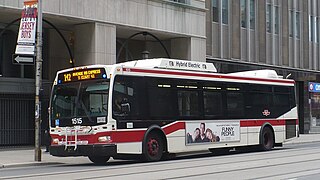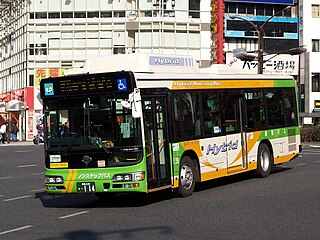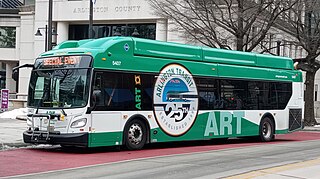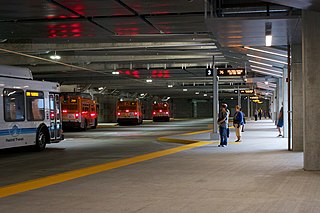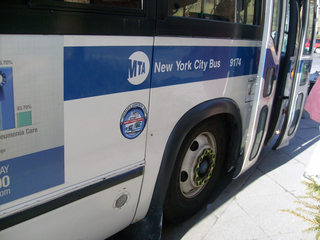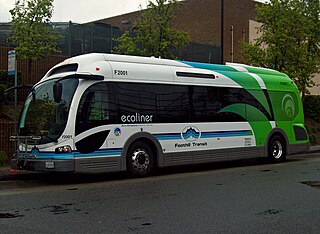Fixed-route fleet details
A roster of the fleet is shown below. Not included below are buses and vans not open to the general public (Access-A-Ride vans, taxicabs, and employee shuttle buses), retired buses, or demonstration buses. This list also does not include buses formerly operated by MTA Long Island Bus (now Nassau Inter-County Express) that are now operated under contract to Nassau County by Transdev.
Local, limited, & Select Bus Service vehicles
All buses listed below have semi-low floors. [28]
| Image | Type | Model year | Length | Numbers (total) | Amount active | Energy source | Operator |
|---|---|---|---|---|---|---|---|
 | Orion Bus Industries Orion VII 07.501 HEV Next Generation | 2009-2010 | 40 ft (12 m) | 3960–4278 4330–4702 (692 buses) | 242 retiring | Diesel-electric hybrid | MTA Bus & NYCT |
 | Nova Bus LFS-A TL62102A 3rd Generation Articulated | 2010 | 62 ft (19 m) | 1200–1289 (90 buses) | 80 retiring | Diesel | NYCT |
 | Nova Bus LFS TL40102A 3rd Generation | 2011 | 40 ft (12 m) | 8000–8089 (90 buses) | 89 | ||
 | Orion Bus Industries Orion VII 07.501 EPA10 3rd Generation | 7000–7089 (90 buses) | 88 | ||||
 | New Flyer XD40 Xcelsior | 4810–4899 (90 buses) | 89 | ||||
 | New Flyer C40LF Low Floor | 2011-2013 | 185–672 (488 buses) | 487 | CNG | MTA Bus & NYCT | |
 | Nova Bus LFS-A TL62102A 1st Generation Articulated | 62 ft (19 m) | 5252–5298 5300–5363 5770–5986 (328 buses) | 328 | Diesel | NYCT | |
 | New Flyer XD60 Xcelsior Articulated | 2012-2013 | 60 ft (18 m) | 4710–4799 (90 buses) | 89 | ||
 | New Flyer XD40 Xcelsior | 2014-2015 | 40 ft (12 m) | 7090–7483 (394 buses) | 392 | MTA Bus & NYCT | |
 | Nova Bus LFS TL40102A 4th Generation | 2015-2016 | 8090–8503 (414 buses) | 412 | NYCT | ||
 | New Flyer XD60 Xcelsior Articulated | 2016 | 60 ft (18 m) | 5364–5438 (75 buses) | 75 | MTA Bus | |
 | New Flyer XN40 Xcelsior | 2017 | 40 ft (12 m) | 673–810 (138 buses) | 136 | CNG | NYCT |
 | New Flyer XD60 Xcelsior Articulated | 60 ft (18 m) | 5987–6125 (139 buses) | 139 | Diesel | MTA Bus & NYCT | |
 | |||||||
 | Nova Bus LFS-A TL62102A 4th Generation Articulated | 2017-2018 | 62 ft (19 m) | 5439–5602 (164 buses) | 164 | NYCT | |
 | |||||||
 | New Flyer XN60 Xcelsior Articulated | 2018 | 60 ft (18 m) | 1000–1109 (110 buses) | 109 | CNG | |
 | |||||||
 | New Flyer XDE40 Xcelsior | 40 ft (12 m) | 9500–9509 (10 buses) | 10 | Diesel-electric hybrid | ||
 | New Flyer XD40 Xcelsior | 2018-2019 | 7484–7850 (367 buses) | 366 | Diesel | ||
 | Nova Bus LFS TL40102A 4th Generation | 8504–8754 (251 buses) | 250 | ||||
 | New Flyer XE60 Xcelsior CHARGE Articulated | 2019 | 60 ft (18 m) | 4950–4964 (15 buses) [29] | 15 | Battery electric | |
 | New Flyer XD60 Xcelsior Articulated | 2019-2020 | 6126–6286 (161 buses) | 161 | Diesel | MTA Bus & NYCT | |
 | |||||||
 | Nova Bus LFS HEV TL40102A 4th Generation | 2021-2022 | 40 ft (12 m) | 9620–9910 (291 buses) | 291 | Diesel-electric hybrid | NYCT |
 | New Flyer XDE40 Xcelsior | 9416–9499 9510–9619 (194 buses) | 194 | ||||
 | Nova Bus LFS TL40102A 4th Generation | 2022-2023 | 8755–8963 (209 buses) | 209 | Diesel | ||
 | New Flyer XD40 Xcelsior | 7851–7989 (139 buses) | 139 | ||||
 | Nova Bus LFS TL40102A 4th Generation | 2023-2024 | 8964–9271 (308 buses) | 140 under delivery | MTA Bus | ||
 | New Flyer XD40 Xcelsior | 9272–9387 (116 buses) | 101 under delivery | ||||
 | New Flyer XE40 Xcelsior CHARGE Next Generation | 4965–5024 (60 buses) | 5 under delivery | Battery electric | NYCT |
Express bus fleet
All express buses are diesel-powered, 45 ft (14 m) long commuter coaches. All buses are high-floored. [30]
| Image | Type | Model year | Numbers (total) | Amount active | Operator |
|---|---|---|---|---|---|
 | Motor Coach Industries D4500CL | 2004-2007 | 3000–3474 (475 buses) | 233 retiring | MTA Bus & NYCT |
 | Motor Coach Industries D4500CT | 2008 | 2195–2250 (56 buses) | 41 retiring | |
 | Prevost X3-45 Commuter 1st Generation | 2012 | 2400–2489 (90 buses) | 89 | NYCT |
 | Motor Coach Industries D4500CT | 2013 | 2251–2304 (54 buses) | 53 | |
 | Prevost X3-45 Commuter 1st Generation | 2014-2016 | 2490–2789 (300 buses) | 297 | |
 | Prevost X3-45 Commuter 2nd Generation | 2021-2022 | 1300–1629 (330 buses) | 330 | MTA Bus & NYCT |
Future bus fleet
These are bus orders that will occur a few years into the future.
| Image | Type | Model year | Length | Numbers (total) | Energy source | Operator |
|---|---|---|---|---|---|---|
| Nova Bus LFSe+ | 2024 | 40 ft (12 m) | TBA (5 buses) | Battery electric | NYCT | |
| New Flyer XHE40 Xcelsior CHARGE H2 | 2025 | TBA (2 buses) | Hydrogen fuel cell | |||
| Motor Coach Industries D45 CRT LE CHARGE | 2025-2026 | 45 ft (14 m) | TBA (5 buses) | Battery electric | ||
| Solaris Bus & Coach Urbino NAe40 | 40 ft (12 m) | TBA (5 buses) | ||||
| New Flyer XE60 Xcelsior CHARGE Articulated | 2025+ | 60 ft (18 m) | TBA (290 buses) | |||
| New Flyer XD60 Xcelsior Articulated | TBA (670 buses) | Diesel | ||||
| Motor Coach Industries D45 CRT | 45 ft (14 m) | TBA (92 buses) | ||||
| New Flyer XE40 Xcelsior CHARGE Next Generation | 40 ft (12 m) | TBA (1,130 buses) | Battery electric | MTA Bus & NYCT | ||
| Prevost X3-45 Commuter 2nd Generation | 45 ft (14 m) | TBA (381 buses) | Diesel | MTA Bus | ||
| TBA |

